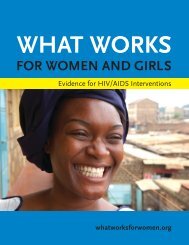Global Tuberculosis Report -- 2012.pdf
Global Tuberculosis Report -- 2012.pdf
Global Tuberculosis Report -- 2012.pdf
Create successful ePaper yourself
Turn your PDF publications into a flip-book with our unique Google optimized e-Paper software.
BOX 3.3Engaging private providers in countries with a large private sectorData reported by countries indicate that NTPs mostly engage non-profi t and institutional care providers as part of their PPM programmes.Establishing collaborative links with these providers is relatively less demanding than engaging for-profi t private providers and, for agiven amount of effort, may yield a higher number of TB case notifi cations. However, engaging more seriously with for-profi t practitioners,especially in countries with a large private sector, is necessary to increase the number of people with TB who are diagnosed early, treatedaccording to international standards and reported to national TB control programmes. It is also required to reduce costs to TB patients,prevent the emergence and spread of drug-resistant TB and protect soon-to-be-available new anti-TB drugs.The extent of the sale and use of anti-TB drugs in the private sector in 10 countries that account for about 60% of estimated TB casesglobally was assessed in 2011. 1 The private markets in four Asian countries (India, Indonesia, Pakistan and the Philippines) had thelargest volumes of sales relative to estimated numbers of TB cases. Annual sales ranged from 65% to 117% of the drugs needed to treatthe estimated number of incident cases occurring each year with a standard 6–8 month regimen in these countries. The study authorsconcluded that expansion of PPM programmes was needed.Efforts to engage public and private health-care providers in TB care and control have been implemented for several years in India,Indonesia, Pakistan and the Philippines. Nonetheless, the reported data indicate that there is substantial scope for greater engagementof the private sector in these and other countries with a large private sector. Disaggregated data on the contribution of providers in theprivate sector to TB case notifi cations is not reported by most countries; among those that do report, the contribution of the large forprofit private sector is too small to be of any signifi cance. The recent decision by the Government of India to make notifi cation of TB casesmandatory by law is a welcome step in the right direction.1Wells WA et al. Size and usage patterns of private TB drug markets in the high burden countries. PLoS One, 2011, 6(5):e18964.FIGURE 3.1Rate per 100 000 population per year200150100500<strong>Global</strong> trends in case notification (black)and estimated TB incidence (green) rates,1990–20111990 1995 2000 2005 2011greater attention to collaboration with for-profit privateproviders, especially in countries where there is a largeprivate medical sector and anti-TB drugs are readily availablein private pharmacies, is highlighted in Box 3.3.A new initiative to engage nongovernmental organizationsin TB care and control, named ENGAGE-TB, isdescribed in Box 3.4.3.3 Trends in case notifications since 1990and estimates of the case detection rate<strong>Global</strong>ly, the number of TB cases diagnosed and notifiedper 100 000 population has stabilized since 2008,following a marked increase between 2001 and 2007(Figure 3.1). <strong>Global</strong>ly and in all WHO regions, a clear gapbetween the numbers of notified cases and the estimatednumbers of incident cases exists, although this is narrowing,particularly in the Western Pacific Region (mostlydriven by trends in China) and the Region of the Americas(Figure 3.2). Trends in the 22 HBCs are shown in Figure3.3, and for other countries are illustrated in countryprofiles that are available online. 1The case detection rate (CDR) 2 for TB is an indicatorthat is included within the Millennium DevelopmentGoals (Chapter 1). For a given country and year, the CDRis calculated as the number of new and relapse TB cases(see Box 3.1 for definitions) that were notified by NTPs(Table 3.1), divided by the estimated number of incident1www.who.int/tb/data2The CDR is actually a ratio rather than a rate, but the term“rate” has become standard terminology in the context of thisindicator.34 GLOBAL TUBERCULOSIS REPORT 2012
















